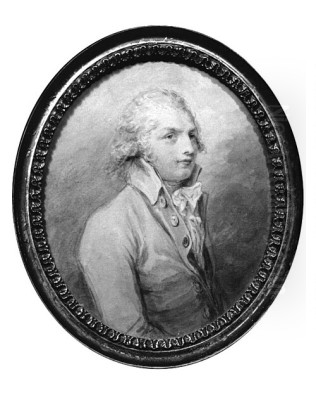
Francis Wheatley stands as a significant figure in the landscape of British art during the latter half of the eighteenth century. Born in London in 1747 and passing away in 1801, his career spanned a dynamic period in British history and artistic development. Primarily recognized as a painter of portraits and conversation pieces, Wheatley also excelled in landscape and genre scenes, capturing the essence of Georgian England with a distinctive charm and sensitivity. His election as a Royal Academician marked his acceptance into the highest echelons of the British art establishment, yet his life was not without its share of turbulence and financial struggle. This exploration delves into the life, artistic style, major works, and enduring legacy of Francis Wheatley, RA.
Early Life and Artistic Training
Francis Wheatley entered the world in Wild Court, Covent Garden, London, a bustling hub of city life. His father was a master tailor, placing the family within the skilled artisan class rather than the aristocracy often associated with art patronage. This background perhaps instilled in Wheatley an early familiarity with the textures and details of everyday life that would later inform his genre paintings. His artistic inclinations were evident early on, leading him to seek formal training.
His initial instruction came at William Shipley's drawing school in the Strand. Shipley's academy was a crucial institution in mid-eighteenth-century London, fostering talent from various backgrounds and emphasizing practical skills. Wheatley proved a promising student, garnering several premiums, or awards, from the Society of Arts (formally, the Society for the Encouragement of Arts, Manufactures and Commerce, founded by Shipley) between 1762 and 1764. This early recognition highlighted his burgeoning talent and ambition.
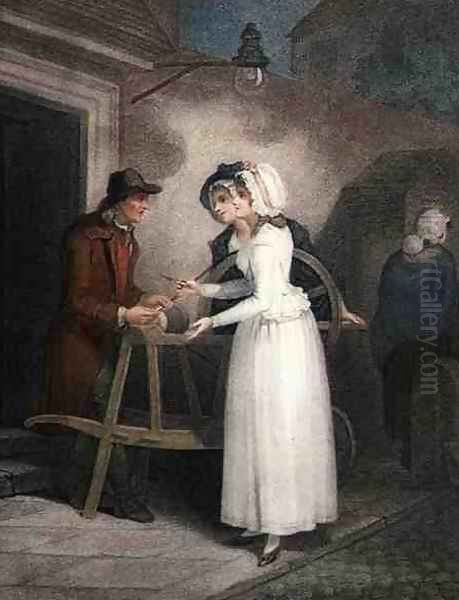
Furthering his education, Wheatley enrolled in the newly established Royal Academy Schools in 1769, the year they opened. The Royal Academy, under its first president Sir Joshua Reynolds, aimed to elevate the status of British art and provide rigorous training based on classical principles and the study of the Old Masters. Studying here exposed Wheatley to the leading artistic theories and figures of the day, including Reynolds himself and the influential history painter Benjamin West. This academic environment undoubtedly refined his technical skills and broadened his artistic horizons.
Formative Influences and Early Career
Wheatley's early career saw him gravitate towards portraiture, a lucrative and highly sought-after genre in Georgian England. His style during the 1770s shows a clear affinity with the work of Johann Zoffany, a German-born painter who popularized the 'conversation piece' in Britain. These were typically small-scale group portraits depicting families or friends in informal domestic or garden settings, often engaged in genteel activities. Wheatley adopted this format with considerable skill, creating charming and detailed representations of middle-class and gentry life.
His paintings from this period are characterized by careful attention to detail in costume and setting, delicate brushwork, and an ability to capture likenesses effectively. He exhibited regularly at the Society of Artists and later at the Royal Academy, gradually building his reputation. He also undertook decorative work, collaborating with the artist John Hamilton Mortimer on painted decorations for the ceilings at Vauxhall Gardens, a popular public pleasure garden in London. This experience likely honed his skills in composition and working on a larger scale. Mortimer, known for his more dramatic and sometimes 'sublime' subjects, may have also influenced Wheatley's occasional forays into historical or literary themes.
Wheatley's talent was recognized, and he secured commissions, but his personal life proved less stable. He lived extravagantly, accumulating significant debts. This financial instability, coupled with a major personal scandal, would soon force a dramatic shift in his life and career trajectory.
Scandal and the Irish Interlude
By the late 1770s, Wheatley's financial situation had become precarious. His problems were compounded by a scandalous affair. He formed a relationship with Elizabeth Gresse, the wife of a fellow artist, John Alexander Gresse. To escape his creditors and the ensuing social fallout, Wheatley fled London in 1779, taking Mrs. Gresse with him and passing her off as his wife. Their destination was Dublin.
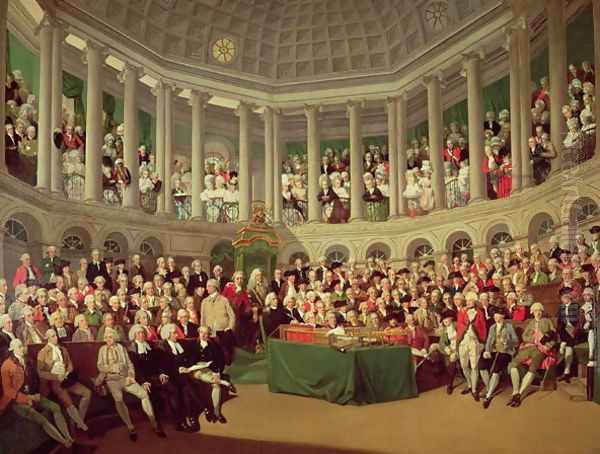
Ireland, at this time, had its own burgeoning artistic scene and a wealthy Anglo-Irish aristocracy eager for portraits and fashionable art. Wheatley quickly established himself in Dublin as a leading portrait painter. He found considerable success, painting many members of Dublin society. His London reputation, despite the scandal surrounding his departure, likely preceded him and opened doors within the Irish capital's elite circles.
During his time in Ireland (roughly 1779-1783), Wheatley continued to paint portraits and conversation pieces, but he also turned his attention increasingly to landscape and genre subjects, perhaps inspired by the Irish scenery and rural life. His most significant work from this period is undoubtedly The Irish House of Commons (1780). This large and complex painting depicts the interior of the Parliament House in Dublin during a famous speech by Henry Grattan advocating for legislative independence. It is a valuable historical document as well as an ambitious group portrait, showcasing Wheatley's skill in managing complex compositions and capturing numerous individual likenesses.
Return to London and the 'Cries of London'
Wheatley's success in Dublin was notable, but his true identity and the nature of his relationship with Mrs. Gresse eventually became known, leading to social difficulties. He returned to London around 1783. Back in the capital, he needed to re-establish his career. He found that public taste was shifting towards more sentimental and picturesque genre scenes, partly influenced by French artists like Jean-Baptiste Greuze and by a growing British interest in rural life and the "common folk," albeit often idealized.
Wheatley adapted skillfully to this trend. He began producing charming rustic scenes, often featuring idealized peasants, market-goers, and cottage settings. These works found favour with the public and print publishers. His style became somewhat broader and more fluid than in his earlier conversation pieces, with warm colours and an emphasis on narrative and sentiment. He often drew comparisons with his contemporary George Morland, who also specialized in rustic and tavern scenes, though Morland's work was often grittier and less polished than Wheatley's.
It was during this period, in the early 1790s, that Wheatley embarked on the project that would secure his lasting fame: the Cries of London. Commissioned by the print publishers Colnaghi, this series originally comprised thirteen paintings depicting various London street vendors hawking their wares. Each image focused on a specific "cry," the traditional call used by sellers to advertise goods like "Milk Below Maids," "Sweet China Oranges," "Fresh Gathered Peas," or "Knives, Scissors, and Razors to Grind."
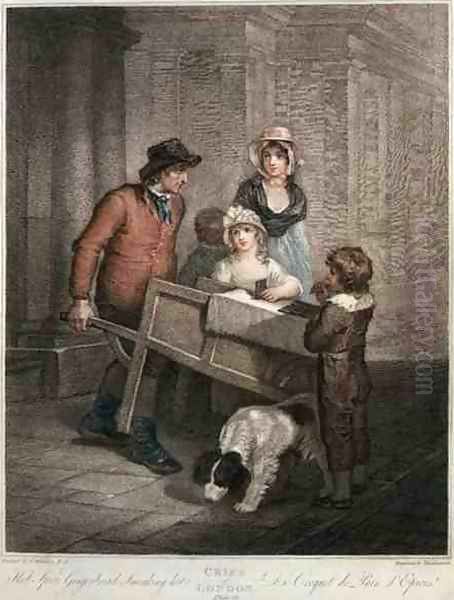
The Cries were an immediate and immense success. Wheatley presented an idealized and picturesque vision of London's street life. His vendors are typically young, attractive, and neatly dressed, set against recognizable London backdrops rendered with charm. The paintings skillfully blended genre realism with fashionable sentimentality. Engraved and published as coloured stipple prints, they became hugely popular, adorning the walls of middle-class homes throughout Britain and beyond. They remain iconic images of Georgian London and are Wheatley's best-known works.
Artistic Style Explored
Francis Wheatley's art occupies a space between the elegance of the Rococo and the emerging sensibilities of Romanticism. His work consistently displays a high level of technical skill, particularly in drawing and the rendering of textures, such as fabrics and foliage.
His early conversation pieces, influenced by Zoffany, show Rococo characteristics in their intimacy, detailed observation, and often light-hearted mood. The figures are elegantly posed, and the settings are rendered with precision. His palette in these works is often clear and bright.
As his career progressed, particularly after his return from Ireland, elements associated with Romanticism became more apparent. This included a greater emphasis on sentiment, an interest in rural and everyday life (albeit often idealized), and a more fluid handling of paint. His landscapes, whether as backdrops or primary subjects, often possess a gentle, picturesque quality, influenced perhaps by the tradition of Thomas Gainsborough, though generally less atmospheric and more detailed than Gainsborough's later work.
Compared to the grand manner portraiture of Sir Joshua Reynolds or the dramatic historical canvases of Benjamin West, Wheatley's art operated on a more intimate and accessible scale. He excelled at narrative genre, telling simple stories through his paintings – a family gathering, a market transaction, a moment of rural labour or rest. His handling of light is generally adept, creating convincing spatial depth and highlighting key figures or details. While capable of complex compositions like The Irish House of Commons, he seemed most comfortable with smaller groups and clearer narrative structures.
Masterworks in Focus
Several works stand out in Wheatley's oeuvre, showcasing his versatility and skill:
The Irish House of Commons (1780): A remarkable achievement in group portraiture and historical documentation. Wheatley manages to capture the grandeur of the setting and the intensity of the political moment, while providing recognizable portraits of numerous key figures. The composition skillfully draws the viewer's eye towards the central speaker, Henry Grattan. It remains an invaluable visual record of a pivotal moment in Irish history.

The Browne Family (c. 1778): An excellent example of Wheatley's conversation pieces from his pre-Ireland period. It depicts the family in a relaxed outdoor setting, likely their estate. The painting showcases his ability to render fashionable attire, capture individual likenesses within a group dynamic, and create a sense of genteel domesticity typical of the genre popularized by Zoffany.
The Cries of London (c. 1792-1795): This series is Wheatley's most famous contribution. Individual plates like "Milk Below Maids" or "Primroses" exemplify the charm and idealized nature of the series. The figures are appealing, the settings picturesque, and the overall mood is one of cheerful industry. While criticized by some for glossing over the hardships of street selling, their enduring popularity speaks to their success in capturing a romanticized vision of urban life that resonated with the public.
The Return from Market (various versions): Wheatley painted several variations on themes of rural life, such as returning from market or resting from labour. These works highlight his move towards sentimental genre in his later career. They typically feature rustic figures, often families, with carts or donkeys laden with goods, set in pleasant landscapes. These paintings emphasize themes of simple virtue, domestic harmony, and the picturesque qualities of country life.
Academic Recognition and Professional Standing
Wheatley's growing reputation, particularly boosted by the success of the Cries, led to official recognition from the art establishment. He was elected an Associate of the Royal Academy (ARA) in 1790. The following year, 1791, he achieved the highest rank, being elected a full Royal Academician (RA).
However, his election as RA was reportedly contentious. His main rival for the position was the young and rapidly rising portraitist Thomas Lawrence. Lawrence, who possessed prodigious talent and charm, already enjoyed favour at court, particularly with King George III and Queen Charlotte. Although Wheatley secured the election, the preference shown towards Lawrence by the monarchy may have limited Wheatley's access to the most prestigious and lucrative royal commissions in his later years. Despite this, his RA status confirmed his position as one of Britain's leading artists.
A Network of Artists: Contemporaries and Context
Francis Wheatley worked within a vibrant and competitive London art world. Understanding his contemporaries helps place his work in context:
Sir Joshua Reynolds (1723-1792): The dominant figure in British art for much of Wheatley's career, first President of the Royal Academy, champion of the 'Grand Manner' in portraiture and history painting.
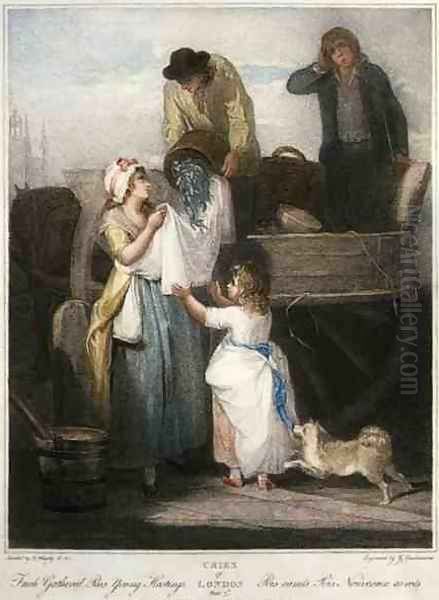
Thomas Gainsborough (1727-1788): Reynolds's main rival, celebrated for his fluid, elegant portraits and his pioneering, atmospheric landscapes. Wheatley's landscapes show some affinity with Gainsborough's picturesque approach.
Johann Zoffany (1733-1810): The master of the conversation piece, whose work directly influenced Wheatley's early portraits.
Benjamin West (1738-1820): American-born painter who succeeded Reynolds as RA President. Famous for large-scale historical paintings, representing the academic ideal Wheatley encountered at the RA Schools.
Richard Wilson (1714-1782): A foundational figure in British landscape painting, known for his classical, idealized landscapes inspired by Claude Lorrain. Wheatley's landscapes are generally less classical and more focused on specific locations or rustic elements.
Paul Sandby (1731-1809): Often called the 'father of English watercolour,' known for his topographical views and scenes of contemporary life.
George Morland (1763-1804): A highly popular painter of rustic genre, animal scenes, and coastal landscapes, often depicting less idealized and more robust aspects of country life than Wheatley.
John Hamilton Mortimer (1740-1779): History painter and etcher, known for dramatic and sometimes macabre subjects ('banditti scenes'). An early associate and collaborator of Wheatley.
Angelica Kauffman (1741-1807): Swiss-born Neoclassical history painter and portraitist, one of only two female founding members of the Royal Academy.
Joseph Wright of Derby (1734-1797): Famed for his dramatic use of chiaroscuro, particularly in scenes depicting scientific experiments and industrial subjects, as well as portraits and landscapes.
Philip James de Loutherbourg (1740-1812): Known for his dramatic landscapes, seascapes, and battle scenes, often with innovative lighting effects influenced by his work in theatre design.
John Alexander Gresse (1741-1794): Drawing master and painter, whose wife Elizabeth eloped with Wheatley, causing the scandal that led to Wheatley's move to Ireland.
This network highlights the diverse artistic environment Wheatley navigated, encompassing grand portraiture, historical epics, burgeoning landscape traditions, and the growing popularity of genre painting.
Later Years, Personal Life, and Legacy
After returning from Ireland, Wheatley married Clara Maria Leigh (c. 1768–1838) in 1788. She was herself a painter, particularly of portraits and miniatures, and exhibited at the Royal Academy. Some sources suggest she may have been his pupil initially. They had several children, including a daughter, also named Clara Maria, who became a notable artist in her own right.
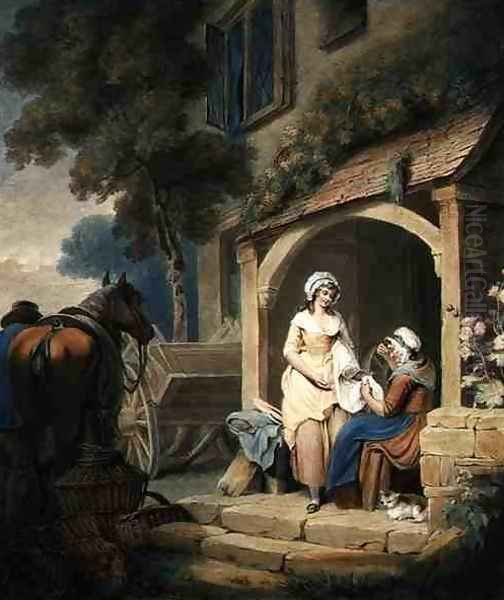
Despite the success of the Cries of London and his RA status, Wheatley seems to have continued to struggle financially in his later years. His earlier extravagance may have left lasting debts, and perhaps the competition from younger artists like Lawrence impacted his portrait commissions. Furthermore, his health declined; he suffered from gout, a painful condition common in the period.
Francis Wheatley died in London on June 28, 1801, at the relatively young age of 54. He left his family in difficult financial circumstances.
His legacy, however, was secure. He remains celebrated for his charming and skillful depictions of Georgian life. While his conversation pieces and portraits are highly regarded examples of their type, it is the Cries of London that cemented his place in popular art history. These images continue to be reproduced and admired for their picturesque vision of eighteenth-century London. His work provides invaluable visual insight into the society, customs, and environments of his time.
Wheatley's paintings are held in major public collections worldwide, including Tate Britain, the British Museum, the Victoria and Albert Museum in London, the National Gallery of Ireland in Dublin, the Yale Center for British Art, and numerous other institutions in the UK, Ireland, and North America. He is remembered as a versatile and accomplished artist who successfully navigated the changing tastes of the Georgian era, leaving behind a body of work that continues to engage and delight viewers today.
Conclusion
Francis Wheatley RA was more than just a painter of pretty pictures. He was a skilled technician, a keen observer of social manners, and an adaptable professional who responded to the artistic currents of his time. From the refined elegance of his early conversation pieces to the historical significance of The Irish House of Commons and the enduring popular appeal of the Cries of London, his work offers a rich tapestry of Georgian life. Though his personal life was marked by instability, his artistic contributions earned him a lasting place in the story of British art, capturing the spirit of his age with sensitivity and charm.